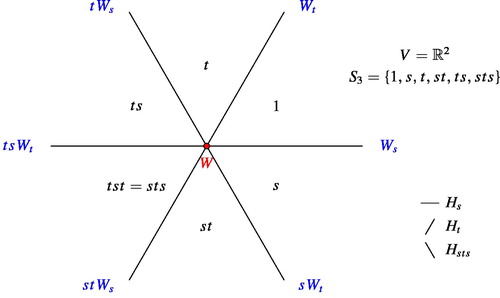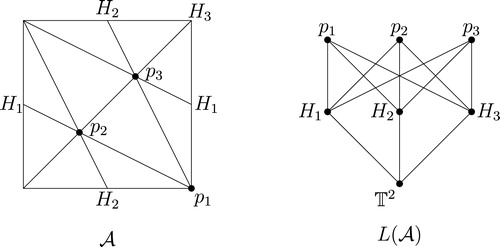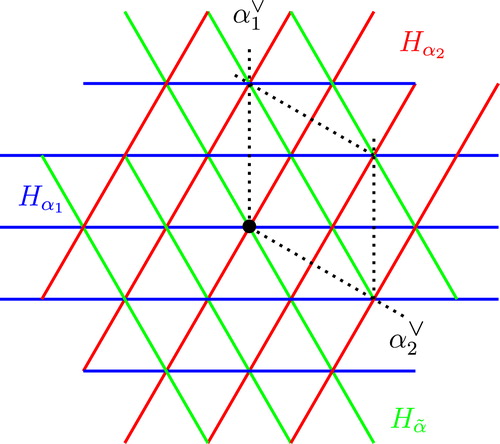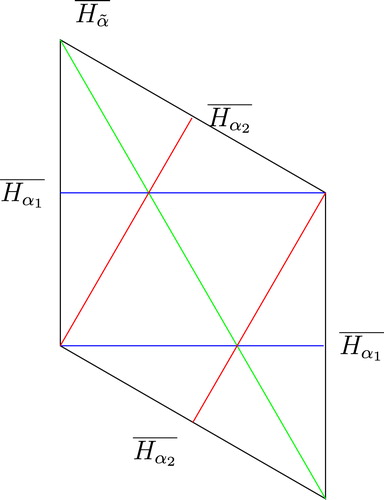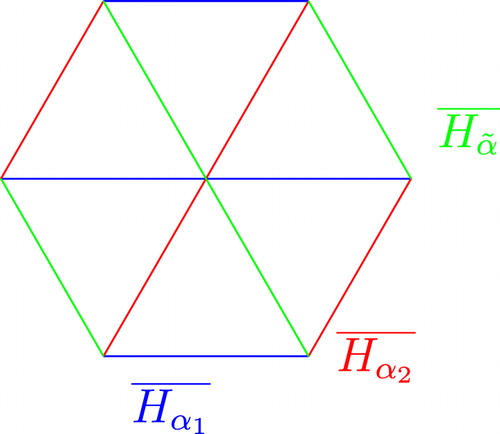 ?Mathematical formulae have been encoded as MathML and are displayed in this HTML version using MathJax in order to improve their display. Uncheck the box to turn MathJax off. This feature requires Javascript. Click on a formula to zoom.
?Mathematical formulae have been encoded as MathML and are displayed in this HTML version using MathJax in order to improve their display. Uncheck the box to turn MathJax off. This feature requires Javascript. Click on a formula to zoom.Abstract
A toric arrangement is a finite collection of codimension-1 subtori in a torus. The intersections of these subtori stratify the ambient torus into faces of various dimensions. The incidence relations among these faces give rise to many interesting combinatorial problems. One such problem is to obtain a closed-form formula for the number of faces in terms of the intrinsic arrangement data. In this paper we focus on toric arrangements defined by crystallographic root systems. Such an arrangement is equipped with an action of the associated Weyl group. The main result is a formula that expresses the face numbers in terms of a sum of indices of certain subgroups of this Weyl group.
1 Introduction
An arrangement of hyperplanes is a locally finite collection of hyperplanes in a vector space. Such a collection defines a stratification of the vector space into relatively open convex subsets. The incidence relations among these strata give rise to interesting problems in combinatorics; many of them still unsolved. The simplest possible example of a hyperplane arrangement is an arrangement of lines in the Euclidean plane. Such a collection determines a stratification of the plane consisting of vertices (intersections of lines), edges (maximal connected components of the lines not containing any vertex) and chambers (maximal connected components of the plane containing neither the edges nor the vertices). The combinatorics that emerges from these intersections is intriguing. This is evident by the number of interesting problems and conjectures described in Grünbaum’s exposition [Citation1]. A classical source for systematic discussion of combinatorial aspects of hyperplane arrangements is [Citation2, Chapter 18]. For a more modern exposition we refer the reader to Richard Stanley’s notes [Citation3].
Let be an arrangement of hyperplanes in
. The rank of
is the dimension of the largest subspace spanned by the normals to hyperplanes in
. An arrangement is essential if it is of rank
. We call
a central arrangement if all the hyperplanes pass through a common point; otherwise we call
a non-central arrangement.
There are two posets associated with , namely, the face poset and the intersection poset. They encode the combinatorial information about the arrangement.
Definition 1
The intersection poset of a hyperplane arrangement
is defined as the set of all nonempty intersections of hyperplanes, including
itself as the empty intersection, ordered by reverse inclusion.
The rank of each element is the codimension of the corresponding intersection. In general is a (meet) semilattice; it is a lattice if and only if the arrangement is central.
Definition 2
The characteristic polynomial of an arrangement is:
where
denotes the Möbius function of
(see Definition 12).
The hyperplanes of induce a stratification of
; the components of each stratum are (relatively) open polyhedra called faces of
.
Definition 3
The face poset of
is the set of all faces ordered by topological inclusion:
if and only if
.
The set of all top-dimensional faces (also called chambers) is denoted by . A natural question regarding chambers asks how does the cardinality
depends on the intersection data? Zaslavsky in his fundamental treatise [Citation4] studied the relationship between the intersection lattice of an arrangement and the number of chambers. His main result is as follows:
Theorem 4
Theorem A [Citation4]
Let be a hyperplane arrangement in
with
as its intersection poset and let
be the associated characteristic polynomial. Then
Given a hyperplane arrangement denote by
the number of
-dimensional faces (for example,
is the number of chambers). One of the combinatorial problems in the theory of hyperplane arrangements is to obtain a complete characterization of these numbers. These numbers satisfy the Euler relation
One would like to find more such relations satisfied by
’s. Another aspect of this problem is to construct a combinatorially defined set whose elements are in one-to-one correspondence with, say,
-dimensional faces of the arrangement. It should be noted that such a problem can only be solved by looking at ‘nice’ families of hyperplane arrangement. We refer the reader to [Citation3] for more details.
Partitioning problems for spaces other than Euclidean and projective spaces have not been extensively studied. To our knowledge the first paper that deals with a more general situation is by Zaslavsky [Citation5]. He derives a formula for counting the number of connected components of a topological space when dissected by finitely many of its subspaces. He showed that not only the combinatorics of the intersections (as encoded by the Möbius function) but also their geometry (as captured by the Euler characteristic) plays a role. In recent years several authors have considered toric arrangements. A toric arrangement is a finite collection of codimension- subtori in a torus. The formula for the number of chambers for such arrangements was first discovered by Ehrenborg et al. in [Citation6]; it also appears in [Citation7] and [Citation8]. Recently, Shnurnikov has characterized the set of all possible values of top-dimensional faces for arrangements in a
-torus in [Citation9] and for arrangements in higher-dimensional tori in [Citation10]. See also [Citation11] for a complete characterization of face numbers in case of arrangements in a
-torus.
The aim of this paper is to derive a closed form formula for the number of faces of toric arrangements defined by crystallographic root systems. The paper is organized as follows. In Section 2 we introduce toric arrangements in full generality and fix notations. In Section 3 we start with a brief exposition on reflection groups, root systems and associated reflection arrangements. Then we move on to introduce toric Weyl arrangements using affine Weyl groups and prove the face counting formula. We also show that these face numbers satisfy Dehn–Sommerville relations.
2 Toric arrangements
The -dimensional torus
is the quotient space
. When identified with the set
it forms an abelian group with the group structure given by the componentwise addition modulo
. There is also a ‘multiplicative’ way of looking at the torus when we consider it as the product
. The group structure here is the componentwise multiplication of complex numbers of modulus
. However, throughout this paper, we stick to the additive way. In this section we define toric arrangements and collect some relevant background material.
We assume the reader’s familiarity with basic algebraic topology and combinatorics. The combinatorics of posets and lattices that we need can be found in Stanley’s book [Citation12].
The field of toric arrangements is fairly recent. Ehrenborg, Readdy and Slone mainly study the problem of enumerating faces of the induced decomposition of the torus in [Citation6]. On the other hand a number theoretic aspect is explored by Lawrence in [Citation7].
We denote by the quotient map. Note that
is also the covering map and
is the universal cover. We say that a
-subspace
of
is rational if it is the kernel of an
matrix
with integer entries. The image
is a closed subgroup of
. Topologically
is disconnected and each connected component is a
-torus. The connected components are known as toric subspaces (or cosets) of
. Let
denote the coset containing
. Then
is a finite abelian group whose order is the number of cosets of
. One can check that every closed subgroup of the torus arises in this manner. It is important to note that the subgroup
depends only on the free abelian group generated by the row-space of
. Hence one can assume that the rows of
form a basis for the row-space. The subgroup
is connected if and only if the greatest common divisor of all the
minors of
is
.
A toric hyperplane is a toric subspace of codimension-, i.e., it is the projection of an affine hyperplane in
. We have the following definition.
Definition 5
A toric arrangement in is a finite collection
of toric hyperplanes.
To every toric arrangement there is an associated periodic hyperplane arrangement in
. The inverse image of each
under the covering map
is the union of parallel integer translates of a codimension-
subspace. We say that a toric arrangement is essential if the associated hyperplane arrangement
is essential. Without loss of generality we assume that a toric arrangement is always essential; which forces
. If this is not the case then the enumerative problems that we consider in this paper reduce to equivalent problems in a torus of smaller dimension.
The hyperplane arrangement induces a stratification of
such that these open strata are relative interiors of convex polytopes. A nonempty subset
is said to be a face of the toric arrangement
if there is a stratum
of
such that
. The dimension of
is the dimension of the support of
and it is denoted by
.
It is important to note that the closure of in
need not be homeomorphic to a disk. While a toric arrangement stratifies the ambient torus, this stratification need not define a regular cell structure but it does have special properties.
Definition 6
A polytopal complex is a cell complex with the following additional data.
| (1) | Every cell | ||||
| (2) | If | ||||
| (3) | For every face | ||||
Example 7
Recall that a -complex is a quotient space of a collection of disjoint simplices obtained by identifying certain of their faces via canonical linear homeomorphisms that preserve the ordering of vertices. This is an example of a polytopal complex where all the indexing polytopes are required to be simplices.
The following lemma is a straightforward application of the fact that the covering map is stratification preserving.
Lemma 8
If is a toric arrangement in
then the induced stratification is polytopal.
Definition 9
The intersection poset of a toric arrangement
is defined to be the set of all connected components arising from all possible intersections of the toric hyperplanes ordered by reverse inclusion.
By convention, the ambient torus corresponds to the empty intersection. The intersection poset is graded by the codimensions of the intersections. Before proceeding further let us look at a couple of examples.
Example 10
Let be the toric arrangement in
obtained by projecting the lines
and
. These toric hyperplanes intersect in three points
and
. The arrangement stratifies the torus into three
-faces, six
-faces and three
-faces. This is not a regular subdivision of the torus since the closure of every
-face is a cylinder. shows the arrangement together with the associated intersection poset.
Example 11
Now consider the arrangement formed by including the projection of the line in the previous arrangement. They intersect in the same three points as above but now there are nine
-faces and six
-faces. The induced stratification is a regular
-complex. shows the arrangement and the associated intersection poset.
Since our focus is on counting the number of various-dimensional faces of a toric arrangement we now turn to the combinatorial aspect. The idea that captures the combinatorics of the intersections is the Möbius function of the arrangement which we now define.
Definition 12
The Möbius function of a toric arrangement is the function defined recursively as follows:
The Möbius function plays an important role in counting the number of faces of an arrangement. The following theorem has appeared in [Citation6, Corollary 3.12], [Citation7, Theorem 3] and [Citation8, Example 5.5].
Theorem 13
Let denote the number of
-dimensional faces of a toric arrangement
. Then we have
In this paper we focus on toric arrangements that arise in the context of crystallographic root systems. Moreover, there is a natural action of a Weyl group associated with these arrangements. The main theorem relates the face numbers of a toric Weyl arrangement to indices of certain subgroups.
3 Linear and toric Weyl arrangements
Recall that a finite reflection group acts naturally on a vector space by fixing reflecting hyperplanes. This forms an interesting class of hyperplane arrangements and the group theoretic data plays an important role in their study. We begin by a quick survey of root systems, finite and affine Weyl groups. We follow Humphrey’s book [Citation13, Chapters 1, 4].
Let be a real vector space of dimension
endowed with a positive definite symmetric bilinear form
. For a vector
the reflection across the linear hyperplane orthogonal to
is given by the formula
Denote by
the codimension-
subspace fixed by
.
Definition 14
A finite set of non-zero vectors in
is called a root system if it satisfies the following conditions:
| (R1) |
| ||||
| (R2) |
| ||||
The elements of are called roots.
Unless otherwise stated we assume that a root system is essential, i.e., it spans
. For a given a root system
the group generated by the reflections
is a finite reflection group. However, not all the reflections are needed to write down a generating set. A subset
is a simple system if
is a vector space basis of
and if each root in
is a linear combination of elements of
with coefficients all of the same sign. The corresponding reflections are called simple reflections.
Theorem 15
[Citation13, Section 1.5]
The group is generated by the simple reflections
. Moreover, it has the following presentation
where
and
is the order of
.
3.1 Linear reflection arrangements
The finite reflection group acts on
via reflections. The set of fixed points of this action is a union of hyperplanes fixed by reflections in
.
Definition 16
Given a finite reflection group corresponding to an essential root system
the reflection arrangement associated to
is
Since we only need positive roots to define the reflection arrangement. Every face
of a reflection arrangement is a cone over a simplex of dimension
. The action of
is simply-transitive on the set of chambers of
. In particular, the number of chambers is equal to
. If
is any chamber, then
is generated by the reflections across the walls of
. The closure
is the strict fundamental domain for the
action on
. Let
be the set of reflections with respect to the walls of
. Then, the stabilizer
of a point
is the subgroup generated by
. In particular,
fixes every point of
, where
is the face containing
.
Example 17
The following is the reflection arrangement corresponding to the symmetric group .
Let be an essential root system. Arbitrarily choose and fix a simple system
. Denote by
the set of generating reflections of
. Finally, let
be the associated reflection arrangement. The fundamental chamber of
is defined as
For a subset
define
Note first that
and second that the set
is a codimension-
face of
contained in
. It is clear that faces
partition
.
As the closure is a strict fundamental domain for the
action given a face
of
there exists a
and
such that
Definition 18
Given a subset of
the subgroup generated by reflections in
is called a parabolic subgroup and is denoted by
.
Note that is the stabilizer of
. The following two results are consequences of the theorems proved in [Citation13, Section 1.12, Section 1.15]. However we provide necessary details for the benefit of the reader.
Proposition 19
For each fixed , the faces
and
are disjoint unless
lie in the same left coset of
, in which case they coincide.
Proof
Fix and suppose
. This implies both
and
are in
. But the
-orbit of
can intersect
in only one point. So
which means the element
belongs to the isotropy subgroup of
. By the definition of
and the fact that isotropy subgroup is generated by the reflections fixing it, we deduce that
is the isotropy subgroup of
. So
which implies the conclusion that
. □
Corollary 20
For two disjoint subsets and
of
the faces
and
are disjoint.
Theorem 21
The number of
-faces of a reflection arrangement
are given by the formula:
Proof
First note that any -face of
is in the
-orbit of some
-face
of
, where
. It follows from Proposition 19 that there is a bijection between the faces of
labeled
and the left cosets
. Hence the orbit stabilizer theorem implies that the number of faces labeled by
is equal to the index of
in
. Now
is obtained by varying
over all the subsets of cardinality
. □
The following corollary appears in [Citation13, Section 1.11] and is proved using a different argument.
Corollary 22
With the notation as before we have
Proof
The proof only requires rewriting the left hand side:
3.2 Toric Weyl arrangements
Since these arrangements arise in the context of affine Weyl groups we quickly revise the relevant details here.
Definition 23
A root system is called crystallographic if it satisfies in addition to (R1) and (R2) the condition
| (R3) | |||||
Definition 24
Let be a root system as before, then call
the coroot corresponding to
. The set of all coroots
is called the dual of
; and it is also a root system in
.
Affine reflections are defined using coroots. These are involutive affine maps which fix a hyperplane not passing through the origin. The group generated by affine reflections is called a Euclidean reflection group. For and
, let
denote an affine hyperplane. The corresponding (affine) reflection is given by the formula
It is easy to see that every affine reflection is a composition of a linear reflection followed by a translation. In particular the following holds:
Definition 25
Let be an essential crystallographic root system. The group generated by all affine reflections
with
and
is called the affine Weyl group and is denoted by
.
Similar to the finite case, the action on
defines an affine hyperplane arrangement.
Definition 26
The affine Weyl arrangement is defined as follows
This hyperplane arrangement is clearly invariant under the action. The arrangement stratifies
into open and bounded convex subsets called faces. In this case the codimension-
faces are called alcoves. The
action on alcoves is simply transitive. For an alcove
, the codimension-
faces of its closure
are called walls of
. Arbitrarily choose and fix a chamber
and let
be the set of reflections with respect to the walls of
. The group
is generated by reflections in
. The following theorem summarizes some important properties of these arrangements and its proof can be found in [Citation13, Section 4.3].
Theorem 27
The alcove is an
-simplex and is a strict fundamental domain for the action of
on
. The stabilizer of a point
is the standard subgroup of
generated by
.
The fundamental alcove is defined by the following inequalities Here
is the unique highest root in
. The faces of
are indexed by proper subsets of
. For a proper subset
Since
is the strict fundamental domain for
action the faces of
are labeled by
for
and for some face
of the fundamental alcove. It is not hard to verify that each reflection in
fix
.
For the affine Weyl group let
denote the subgroup generated by linear reflections, i.e., reflections of the form
. Then structure of
can be explained in terms of
and a lattice in
.
Theorem 28
There are points such that their stabilizer subgroup is isomorphic to
. Moreover, there is a surjection
such that the kernel is isomorphic to the lattice
generated by coroots and we have the following semi-direct product structure:
Since the root system is essential the translation subgroup is isomorphic to , the free abelian group of rank
. The non-identity elements of
act by translation and consequently have no fixed points. Moreover this action also preserves the arrangement
. The quotient
is homeomorphic to the compact torus
. We call this torus the coroot torus. The
-orbits of the affine hyperplanes in
define a toric arrangement in
. Two hyperplanes
and
in
define the same toric hyperplane in the coroot torus if and only if one is a translate of the other by a coroot. In particular, we have the following two situations:
Definition 29
Given an affine Weyl group and the corresponding root system
the toric Weyl arrangement is the following collection of toric hyperplanes in the coroot torus
Example 30
Consider the affine Weyl group of type ; it is isomorphic to
(
is the symmetric group on three letters). Its reflection action on
fixes three families of parallel lines. shows the reflecting hyperplanes and the simple coroots.
In the toric Weyl arrangement of type is drawn in the fundamental parallelogram.
4 The face counting formula
In order to relate the face numbers with the indices of parabolic subgroups it is convenient to consider a different fundamental domain.
Proposition 31
The coroot torus can be identified with the
-orbits of the closed fundamental alcove
.
Proof
Pick a point . Then the set
is an open neighborhood of the origin homeomorphic to
. Observe that
since all the translates are disjoint. Since the closed alcove
is a strict fundamental domain for the
-action, every point of
is equivalent modulo
to the compact set
. □
Example 32
We redraw the toric Weyl arrangement of type with the new fundamental domain. shows the arrangement; here the coroot torus is obtained by identifying opposite edges of a regular hexagon.
Similar to the finite case one can define parabolic subgroups of . Let
be a subset of
and
be the subgroup generated by reflections in
. Then
is finite if and only if
. Moreover, in this case
stabilizes
(see [Citation13, Sections 4.7, 4.8]).
Theorem 33
The number of
-faces of
are given by the formula
Proof
The proof is similar to that of Theorem 21. First recall that there exactly reflections in
. Now note that faces of
are labeled by
, where
and
is a face of
. Consequently, they are in bijection with left cosets
. Now apply the orbit stabilizer theorem. □
4.1 The Dehn–Sommerville relations
Since the Euler characteristic of a positive-dimensional torus is the face numbers of a toric arrangement satisfy the following relation:
However, this relation does not provide a complete characterization of face numbers. In this section we prove a necessary condition that is satisfied by the face numbers of a toric Weyl arrangement.
We say that a toric arrangement is simplicial if the induced stratification is that of a -complex. Note that a simplicial arrangement need not define the structure of a simplicial complex on the torus. For example, the arrangement in Example 11 is a simplicial arrangement such that the resulting stratification is not a simplicial complex. The arrangement consisting of the line
is also simplicial however the stratification is not even regular.
Face numbers of simplicial polytopes satisfy special kind of relations known as the Dehn–Sommerville relations [Citation2, Section 9.2]. It was shown by Klee in [Citation14] that similar relations are satisfied by simplicial complexes that arise as triangulations of closed manifolds.
Theorem 34
Let be a simplicial complex homeomorphic to a closed
-manifold and let
denote the number of
-simplices. Then the face numbers of
satisfy the following Dehn–Sommerville relations
(3)
(3) for
.
Define an upper triangular, integer matrix
as follows
The face vector of
is an
-tuple
whose components are face numbers of
. Then Eq. (Equation3
(3)
(3) ) can be rewritten as
.
Lemma 35
Let be a non-regular
-complex. Then its first barycentric subdivision is a regular
-complex and the second subdivision is a simplicial complex.
Proof
See [Citation15, Section 10.3]. □
In view of the above lemma we need to show that the Dehn–Sommerville relations remain invariant under barycentric subdivision. As a first step we figure out a relationship between the face numbers of an -dimensional
-complex
, and the face numbers of its barycentric subdivision. Denote by
the face vector of the barycentric subdivision
.
Lemma 36
Let be an
integer matrix with the entries
Then
.
Proof
See [Citation16, Lemma 2.1]. Note that since the matrix
is invertible. □
Theorem 37
If the face vector of the subdivision
satisfies Dehn–Sommerville relations then so does the face vector
of
.
Proof
First observe that . Now the proof is straightforward.
Corollary 38
The face numbers of a toric Weyl arrangement satisfy the Dehn–Sommerville relations.
Notes
Peer review under responsibility of Kalasalingam University.
References
- Grünbaum B. Arrangements and Spreads CBMS Reg. Conf. Ser. Math. vol. 10 (1972) American Mathematical Society. Providence, R.I.. iv+114.
- Grünbaum B. Convex Polytopes Pure and Applied Mathematics vol. 16 (1967) Wiley Interscience. New York. xiv+456.
- Stanley R.P. An introduction to hyperplane arrangements Geometric Combinatorics IAS/Park City Math. Ser. vol. 13 (2007) Amer. Math. Soc.. Providence, RI. 389–496.
- Zaslavsky T. Facing up to arrangements: face-count formulas for partitions of space by hyperplanes Mem. Amer. Math. Soc. 1 1 Special Issue: Special Issue: International Conference on Discrete Mathematics 1975 154
- Zaslavsky T. A combinatorial analysis of topological dissections Adv. Math. 25 3 1977 267 285
- Ehrenborg R. Readdy M. Slone M. Affine and toric hyperplane arrangements Discrete Comput. Geom. 41 4 2009 481 512
- Lawrence J. Enumeration in torus arrangements European J. Combin. 32 6 2011 870 881
- Deshpande P. On a generalization of Zaslavsky’s theorem for hyperplane arrangements Ann. Comb. 18 1 Special Issue: Special Issue: International Conference on Discrete Mathematics 2014 35 55
- Shnurnikov I.N. On the number of regions formed by sets of closed geodesics on flat surfaces Mat. Zametki 90 4 2011 637 640
- I. Shnurnikov, On the number of connected components of complements to arrangements of subtori http://arxiv:1412.8722 [math.AT].
- K. Chandrashekhar, P. Deshpande, Face enumeration for line arrangements in a 2-torus http://arxiv:1404.1665 [math.CO].
- Stanley R.P. Enumerative Combinatorics. Volume 1 Cambridge Studies in Advanced Mathematics vol. 49 (1997) Cambridge University Press. Cambridge. xiv+626.
- Humphreys J.E. Reflection Groups and Coxeter Groups Cambridge Studies in Advanced Mathematics vol. 29 (1990) Cambridge University Press. Cambridge. xii+204.
- Klee V. A combinatorial analogue of Poincaré’s duality theorem Canad. J. Math. 16 1964 517 531
- Kozlov D. Combinatorial Algebraic Topology Algorithms and Computation in Mathematics vol. 21 (2008) Springer. Berlin. xx+389.
- Brenti F. Welker V. f-vectors of barycentric subdivisions Math. Z. 259 4 2008 849 865

